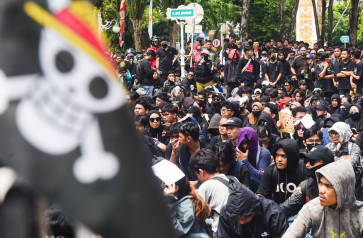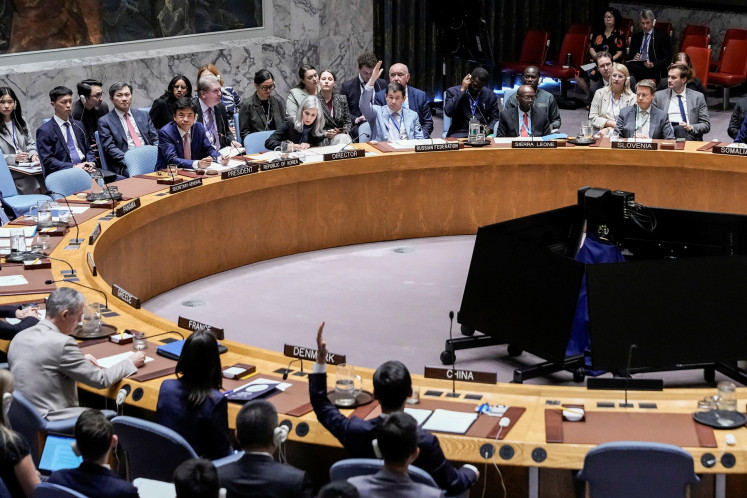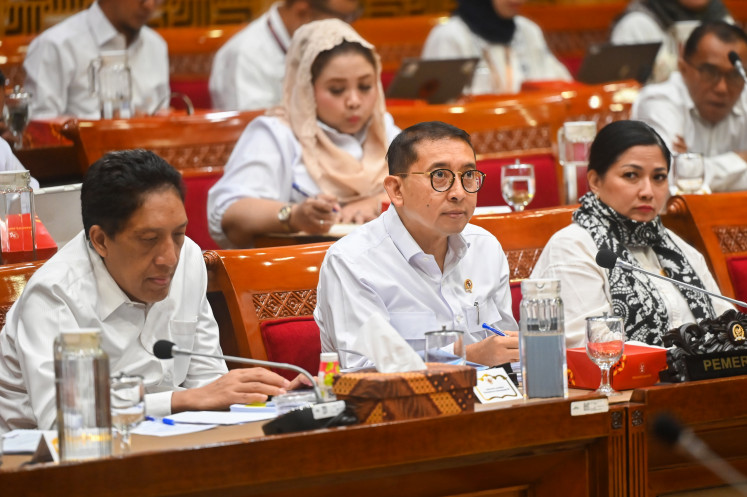Popular Reads
Top Results
Can't find what you're looking for?
View all search resultsPopular Reads
Top Results
Can't find what you're looking for?
View all search resultsRI-France mission for tsunami warning system kicks off
Ready to sail: Crew members chat on France’s largest research vessel, the R/V Marion Dufresne, in port in Jakarta on Sunday
Change text size
Gift Premium Articles
to Anyone
R
span class="caption">Ready to sail: Crew members chat on France’s largest research vessel, the R/V Marion Dufresne, in port in Jakarta on Sunday. Scientists from Indonesia and France started on Monday on an expedition to get information to support a disaster early-warning system.(JP/Ibrahim Irsyad)
Scientists from Indonesia and France launched an expedition on Monday to study the rupture of the great 2012 earthquake on the west coast of Sumatra that is expected to yield information to support an early warning system for disasters.
Initiated by the Indonesian Institute of Science (LIPI) and France’s Institute de Physique du Globe de Paris (IPGP), the month-long sea expedition of more than 30 scientists on France’s largest research vessel, the R/V Marion Dufresne, departed from Jakarta and is set to return on Oct. 21.
The mission, known as the MIRAGE II expedition, is a follow-up to a similar one last year that produced images of a section of the seabed that had yet to rupture from an earthquake. As the seabed area in question could rupture at any time, like nearby sections, it is of fundamental importance for the scientists to study it.
Nugroho Hananto, the LIPI researcher who led the first MIRAGE expedition, said that it had recovered data from 90,000 square kilometers of underwater terrain and he emphasized that the unruptured seabed discovered had previously been undetected by the seismograph system. He said the expected outcome of the second expedition was to learn about the geodynamics of the area.
“It is very hard to say when the next earthquake will hit you, but with the Asian region being a hotbed of tectonic activity, it is important to conduct research to discover which earthquakes can lead to tsunami and why,” he told reporters on Sunday.
The MIRAGE II voyage is being led by Satish Singh, a marine geophysicist from IPGP, and supported by Nanyang Technological University and its Earth Observatory of Singapore (EOS).
In April 2012 an earthquake measuring 8.6 on the Richter scale hit off the coast of Sumatra in a disaster that caused great panic on the island, which had been devastated by a large tsunami in 2004. Fortunately, despite the earthquake being one of the largest ever recorded in the ocean, no tsunami was triggered at the time.
However, Singh said he considered researchers still had unanswered questions surrounding the 2012 incident.
“What happened in 2012? How did an earthquake rupture at the time without a plate boundary and how long was the rupture?” he asked.
Singh added that the second expedition was aimed at advancing the understanding of the anatomy of this new plate boundary, its history and how it affected the rupture patterns and faults during the 2012 earthquake.
Nugroho said that while it was almost impossible to predict earthquakes and tsunami, the MIRAGE expeditions would be able to come up with scientific information on the location of the source of disasters. All the acquired data would be shared publicly with other scientists and research organizations.
“The result would be able to update the Indonesian earthquake map and provide us with better preparation in the future,” he continued.










